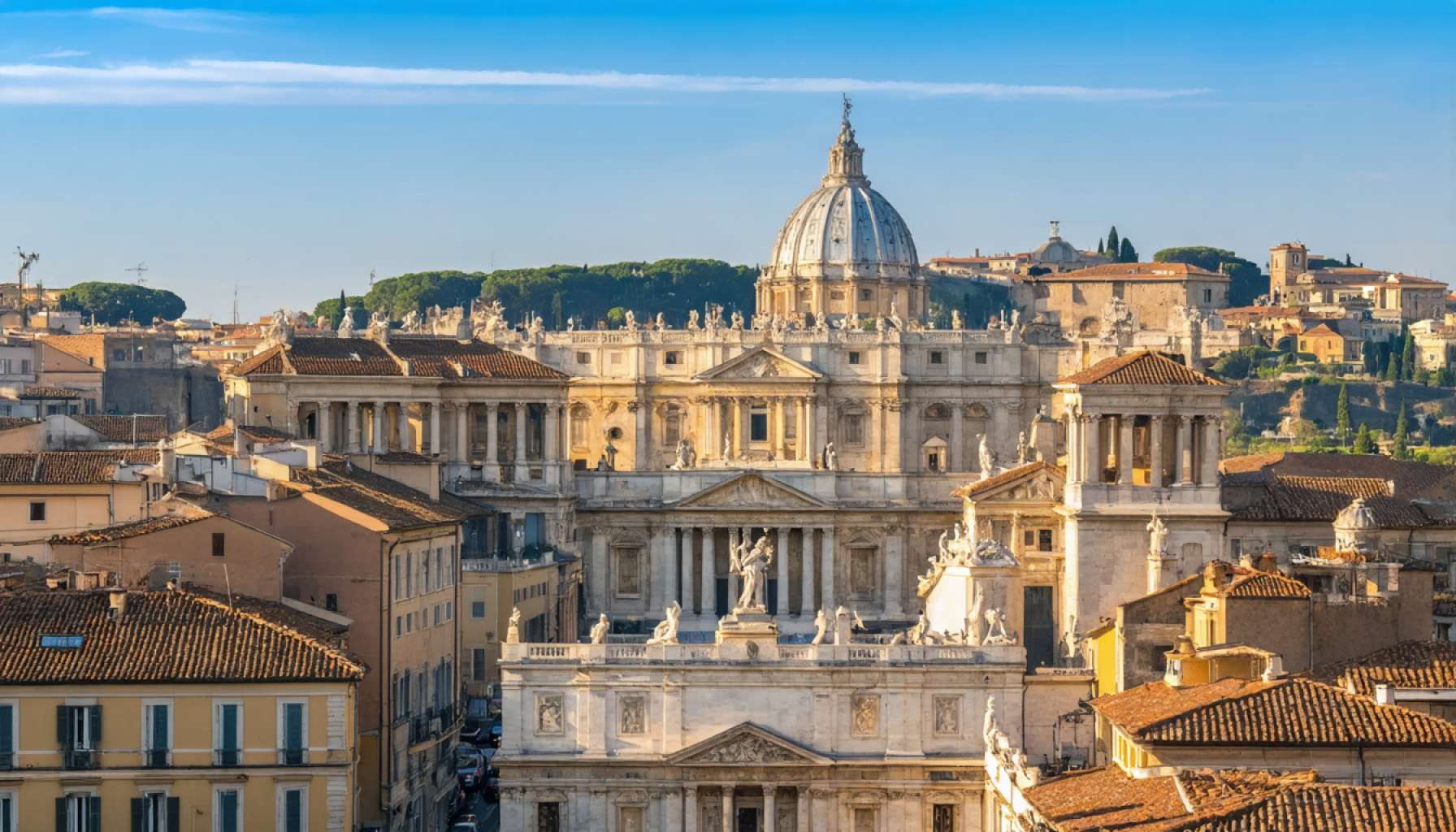
- Italy’s real estate market is shifting focus towards energy efficiency, driven by the European Green Deal.
- Milan leads with large urban regeneration projects, while Rome faces challenges in achieving high energy efficiency due to its historic core.
- Bologna, Naples, and Palermo show growth in new builds, contrasting with Rome’s significant 14% decrease in property transactions.
- Despite declining demand, Milan’s real estate still holds nearly half of Italy’s market value, with housing prices rising 4.8% on average.
- In Rome, demand for three-room apartments is high, with only 24% of seekers securing them.
- Rome’s rental market is strained by the prevalence of short-term tourist rentals, impacting long-term affordability.
- Quick property sales in Rome depend on competitive pricing, with closing times ranging from months to over half a year.
- The real estate landscape in Rome balances historical heritage with modern demands.
When imagining the real estate landscape as a battlefield for urban progress, where does the compass currently point? In Italy, a nation celebrated for its historic architecture, the focus is shifting towards a balance between tradition and modernity. Rome, with its storied past, presents a unique canvas where new and old intersect, but increasingly, efficiency is becoming the hallmark of modern housing.
Energy Efficiency: A New Anthem in Real Estate
In vibrant discussions across the country, the topic of energy efficiency has become paramount. While in the past Italy often seemed hesitant to fully embrace modern sustainability practices, now, more than ever, new constructions are taking center stage. These new developments are outpacing their historic counterparts, particularly in their compliance with energy efficiency standards—a key requirement under the stringent expectations of the European Green Deal.
Cities like Milan spearhead these efforts, capitalizing on large urban regeneration projects. However, Rome’s historic core remains a challenge, with limited new constructions concentrated in peripheral areas. Here, the possibility of achieving high energy efficiency is elusive against a backdrop of ancient stone and timeless grandeur.
Market Dynamics: A Tale of Two Cities
As change sweeps through Italy, the housing markets in metropolitan areas face a crossroads. A report indicates that Bologna, Naples, and Palermo emerge as the few flourishing markets, bucking the national trend with noticeable growth in new builds, while Rome contends with significant slowdowns. The Eternal City recorded a sharp 14% decrease in property transactions, revealing a dichotomy between new desires and ancient landscapes.
Meanwhile, demand for new housing declines—an annual drop of 5.5% reflects broader hesitations. Yet, paradoxically, sale prices climb, charting an average increase of 4.8%. Milan, despite its overall reductions, still claims the title of economic powerhouse, its real estate ventures contributing nearly half of the total market value among Italy’s metropolitan giants.
The Snapshot of Roman Seekers
In Rome, the quintessential buyer dreams of a three-room apartment, a family-centric choice reflecting traditional living ideals. However, the competition is fierce. Only 24% of buyers can claim one of these coveted spaces, placing Rome second in demand behind Bari.
Leonardo Silvestrini, a seasoned real estate agent, notes that despite the demand, the market remains adaptive to change. While some peripheral zones lag behind, Prati is thriving. The area glows under the influence of urban regeneration fueled by funds for the Jubilee celebrations, becoming a beacon of growth with its strategic proximity to both the Vatican and historical wonders.
Navigating the Rental Labyrinth
Rome’s rental market tells another tale—one of scarcity and sharp edges. The dominance of short-term rentals, driven by lucrative tourist interest, reshapes availability and affordability for long-term residents. As legal frameworks inadequately shield landlords from tenant defaults, many favor tourism-driven rentals, a dilemma pressing the local populace towards pricier leases in an already costly city.
Nonetheless, Silvestrini suggests vigilance over this apparent prosperity. With global influences and local policies continuously in flux, the rental market’s golden age could face abrupt shifts.
From Prospect to Ownership
In these evolving times, Rome’s real estate journey demands agile navigation. Quick closings are no rarity in the current climate, provided prices align with market realities. Engage swiftly, with a market-appropriate offer, and homes can transition from listing to sold within mere months. Conversely, misaligned figures extend waits, stretching the purchase timeline to as long as eight months.
The eternal allure of Rome, with its blend of historical brilliance and resilient modernity, remains at the heart of its property saga. For prospective buyers and seasoned investors alike, the challenge lies in harmonizing an ancient heritage with the promises of tomorrow. The market speaks a language of balance, urging participants to consider both efficiency and elegance in their pursuit of Roman residencies.
Unlocking the Future of Italian Real Estate: Tradition Meets Modernity in a Sustainability-Driven Market
Energy Efficiency in Italian Real Estate: A Cultural Shift
With global pressures mounting to combat climate change, Italy is witnessing a transformation in its real estate sector, emphasizing energy efficiency. This change aligns with the European Green Deal, which mandates stricter energy standards. The move towards sustainability is not just a policy requirement; it’s becoming the new norm in property development. Innovative projects in cities like link name Milan have demonstrated how contemporary architecture can coexist with historical settings, all the while meeting ecological benchmarks.
How to Achieve Energy Efficiency in Historic Settings
1. Retrofitting: Implementing state-of-the-art insulation and glazing techniques to minimize energy loss in older buildings.
2. Renewable Energy Integration: Using solar panels and geothermal energy systems that blend well with historical aesthetics.
3. Smart Technologies: Employing IoT-based solutions for optimal energy management in homes, maintaining a balance between luxury and sustainability.
These techniques can significantly reduce the carbon footprint while preserving the cultural heritage that defines cities like Rome.
Market Dynamics: Challenges and Opportunities
The Italian real estate landscape is a complex puzzle shaped by various forces. While cities like Rome see a decrease in property transactions, others like Bologna find growth spurts. This disparity highlights the growing need for adaptable strategies:
– Diversification: Investors should consider secondary cities where growth potential is higher and risks may be lower.
– Tourism Influence: Real estate adjacent to tourist attractions remains lucrative, although it risks alienating local residents due to rising costs.
Real-World Use Cases and Forecasts
Italy’s real estate market presents unique opportunities and challenges:
– Urban Regeneration: Investment in areas marked for urban regeneration can yield high returns, given their focus on sustainability and modern infrastructure.
– Tourist-Driven Income: Properties geared towards short-term rentals can be incredibly profitable, particularly in tourism-heavy locales, though they come with regulatory risks.
Reviews and Comparisons: A Tale of Two Cities
– Rome vs. Milan: While Rome’s market clings to its cultural heritage, Milan is Italy’s economic powerhouse, fostering innovation and modern living solutions.
– Housing Affordability: Property prices continue to rise, a phenomenon echoed in cities globally, prompting the necessity for affordable housing solutions.
Insights and Predictions
The future of Italian real estate will increasingly pivot on the axis of sustainability. With the growing importance of green living:
– Expect increasing regulations and incentives to boost eco-friendly construction.
– There will be a greater focus on smart cities, integrating technology for better urban living.
– Despite the challenge, opportunities remain ripe for those willing to navigate the intricacies of a culturally rich but economically challenging market.
Quick Tips for Prospective Buyers
– Act Swiftly: The competitive landscape demands prompt action once a desirable property is identified.
– Consult Experts: Real estate agents with local insight can offer indispensable guidance through complex transactions.
– Look Beyond Rome: Opportunities in cities like Bologna and Naples can offer promising returns with less competition.
As you explore the dynamic world of Italian real estate, balancing traditional allure with modern efficiency, remember to leverage local expertise and consider the broader market trends to make the most informed investment decisions.



